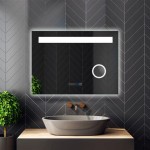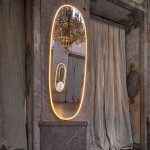Creating an Entire Wall Mirror in Revit
Revit offers several methods for creating a mirrored wall effect. While Revit doesn't have a specific "mirror wall" tool, users can achieve this visual using various techniques, each offering different levels of control and flexibility. This article explores the common methods and highlights their respective advantages and limitations.
Using Wall Sweeps: One of the most common approaches involves utilizing wall sweeps. A wall sweep is a profile extruded along the path of a wall. To create a mirrored wall appearance, a thin rectangular profile representing the mirror's thickness can be created. This profile is then applied as a wall sweep to the designated wall. This method allows for accurate control over the mirror's thickness and ensures seamless integration with the wall element. Users can also schedule wall sweeps, which can be beneficial for quantity takeoffs and material estimations.
Creating a Curtain Wall: Another effective technique involves creating a curtain wall and applying a mirrored material to its panels. This approach offers greater flexibility for complex wall shapes and designs. Users can define the curtain wall grid pattern, panel sizes, and mullion profiles to create a realistic representation of a framed mirror. The mirrored material can be created using a generic material with a high reflectivity value assigned to its appearance asset. This method provides a visually accurate representation of a large, framed mirror wall.
Leveraging Generic Models: A more versatile method utilizes generic models. A rectangular or irregularly shaped generic model can be created to represent the mirror. This model can then be placed directly onto the wall surface using the "Place on Face" tool. This offers the most flexibility in terms of shape and placement. Users can easily create mirrored surfaces on curved walls or angled surfaces using this approach. The mirrored appearance is achieved by applying a mirrored material to the generic model's surface.
Applying a Mirrored Material to an Existing Wall: While not strictly creating a mirrored wall object, users can achieve a similar visual effect by applying a mirrored material directly to the finish layer of an existing wall. This is the simplest method but offers the least control over the mirror’s representation. It can be suitable for quick visualizations or conceptual designs where detailed modeling isn't required. However, this method does not allow for physical properties like thickness or interaction with other elements like wall sweeps or reveals.
Considerations for Material Creation: Regardless of the chosen method, creating a convincing mirrored material is crucial. Revit's material editor allows for a wide range of material properties to be defined. For a mirrored surface, the reflectivity value within the material's appearance asset should be set high. Users can also experiment with glossiness and other parameters to achieve the desired visual effect. Using a specific "Mirror" shader if available within the rendering engine further enhances realism. It's also possible to use an image-based environment map to reflect surrounding objects in the mirror, creating a more immersive and accurate reflection.
Understanding the Limitations: While these methods effectively create the visual representation of a mirrored wall, it's important to understand their limitations. These representations are primarily for visualization purposes. Revit's built-in ray tracing capabilities may not accurately simulate the complex physics of light reflection in a true mirror. For highly accurate reflections and light studies, dedicated rendering software might be necessary. Additionally, the performance impact of using highly reflective materials should be considered, especially in complex models. Optimizing material settings and rendering settings can help mitigate performance issues.
Choosing the Right Method: The most appropriate method depends on the specific project requirements. For simple visualizations, applying a mirrored material directly to a wall might suffice. For detailed modeling and quantity estimations, wall sweeps offer greater control and precision. Curtain walls provide flexibility for complex designs and framed mirror representations. Generic models offer the most versatility in terms of shape and placement, especially for non-standard wall geometries. Carefully evaluating the project needs and understanding the advantages and limitations of each method will ensure optimal results.
Working with Families: For more complex mirror assemblies or for reusable mirror elements, creating a Revit family can be highly beneficial. A family allows for parameterized control over dimensions, materials, and other properties. This is particularly useful for scenarios involving recurring mirror designs or situations where specific manufacturer details need to be incorporated. Families can be created for different mirror types, such as framed mirrors, beveled mirrors, or mirrors with integrated lighting. These families can then be easily placed and modified within the project, improving efficiency and consistency.
Integrating with Rendering Engines: The final visual representation of the mirrored wall depends significantly on the rendering engine used. Different rendering engines offer varying levels of realism and accuracy in simulating reflections. Understanding the capabilities of the chosen rendering engine and adjusting the material properties accordingly is essential for achieving the desired visual outcome. Some rendering engines offer advanced features such as ray tracing and global illumination, which can significantly enhance the realism of mirrored surfaces.
By understanding these different approaches and their respective advantages and limitations, users can effectively create realistic and visually appealing mirrored wall effects within their Revit projects. Selecting the appropriate method based on project requirements and understanding the interplay between material properties and rendering engines will contribute to successful implementation and accurate visualization.

Revitcity Com Object Mirror With Built In Lighting
Bim Objects Free A1080 Mirror Posture Wall Mounted Bimobject

Revitcity Com Modeling A Bathroom Mirror

Rotating And Mirror A Whole Project In Revit

Mirror Wall Revit Espejo Muro Bimshares
Bim Objects Free Revit Sanitary Mirrors Bimobject

Mirror For Revit Architecture 2024 Modlar Com

Revit Smart How To Mirror Flip A Project Quickly And Easily

Mirror Wall Revit Espejo Muro Bimshares
Bim Objects Free Furniture Mirrors Bimobject








